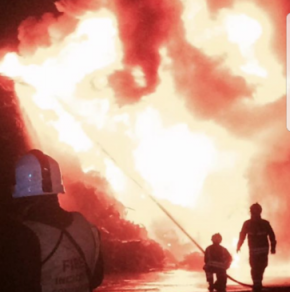
Wrightstyle discusses protecting the workplace against fire
Wrightstyle‘s marketing director, Jane Embury, takes a look at accidental fires in the workplace and discusses how to avoid them.
Every year in the UK more than 20,000 non-residential fires are reported, with many of those happening in our workplaces. While there are a large number of reasons why fires start, many incidents could be avoided if people better understood and managed the most common causes of fire.
Preventing workplace fire loss requires knowledge of both the underlying ignition risks and, if fire does break out, the reasons why the fire might spread. The main element that then determines the severity of a fire is the availability of a fuel load – the combustible materials that a fire needs to develop and grow.
Faulty electrics are the biggest cause of workplace fires and workplaces are legally obliged to properly maintain all electrical equipment and to conduct Portable Appliance Testing (PAT) at least annually. These tests ensure that electrical goods are fit for purpose and remain in good working order. Failure to test annually is therefore not only a fire risk in itself, but could result in legal penalty.
What’s also needed is a comprehensive fire safety risk assessment, particularly vital if combustible and flammable materials are used in the workplace. That assessment will then guide a fire safety plan to ensure the most appropriate storage, handling and disposal of flammable materials. Again, failure to comply with the fire and safety regulations is a fire risk in itself and, again, could result in prosecution.
It’s not just complacency that’s the main fire risk though, because accidents can happen. Although, while accidents can and do happen, a bigger threat is negligence because, in the event of serious incident, the company concerned may lose any right to insurance recompense, leading inevitably to financial difficulty and possible closure.
While every company must have a named person responsible for fire safety, everyone in an organisation also has personal responsibility, because everyone must be aware of fire risk, proper procedures, and what to do in the event of fire. It’s crucial that the workplace has sufficient and appropriate fire safety equipment, and that staff are fully trained in their use.
As Wrightstyle constantly points out, one of the main lessons for building designers and owners is not simply to incorporate passive and active fire systems, but to look at the whole building’s capacity to withstand a fire.
Consequently, advanced glazing systems play an important part. Either for the exterior envelope of a building, or for internal screens and fire doors, advanced glazing systems can provide up to 120 minutes of protection against the spread of fire, smoke or toxic gases.
In addition, Advanced glazing systems also contain the fire, and therefore, minimise damage to that company’s workplace and better provide continuity of operations. An advanced glazing system is, if you like, an investment in peace of mind.
Wrightstyle,
Unit 2&7 Banda Trading Estate,
Nursteed Road,
Devizes,
United Kingdom,
SN10 3DY
Visit Supplier's page
Latest news

28th March 2025
Ideal Heating Commercial announces 10-year warranty on Evomax 2 boiler
Evomax 2, the UK’s number one selling commercial wall-mounted boiler from Ideal Heating Commercial, is now available with a 10-year warranty.
Posted in Articles, Building Industry News, Building Products & Structures, Building Regulations & Accreditations, Building Services, Facility Management & Building Services, Heating Systems, Controls and Management, Heating, Ventilation and Air Conditioning - HVAC, Innovations & New Products, Pipes, Pipes & Fittings, Plumbing, Retrofit & Renovation, Sustainability & Energy Efficiency, Videos
28th March 2025
FLIR Si1-LD Acoustic Imaging Camera for Compressed Air Leak Detection
FLIR, a Teledyne Technologies company, introduces the Si1-LD, an industrial acoustic imaging camera that brings faster and more accurate compressed air leak detection to those operating on a modest condition monitoring budget.
Posted in Acoustics, Noise & Vibration Control, Articles, Building Industry News, Building Products & Structures, Building Services, Facility Management & Building Services, Information Technology, Innovations & New Products, Retrofit & Renovation, Sustainability & Energy Efficiency, Thermal Imaging and Monitors
28th March 2025
LIFTEX 2025 Seminar programme announced
Registration has opened for LIFTEX 2025. Now in its 37th year, LIFTEX 2025 is the UK’s only dedicated exhibition for the lift, escalator and access industry and takes place only once every three years.
Posted in Access Control & Door Entry Systems, Accessibility, Articles, Building Industry Events, Building Industry News, Building Products & Structures, Building Regulations & Accreditations, Building Services, Exhibitions and Conferences, Facility Management & Building Services, Health & Safety, Retrofit & Renovation, Security and Fire Protection, Seminars
28th March 2025
MCRMA welcomes ArcelorMittal UK to membership
A UK division of the global steelmaking business ArcelorMittal has become the latest new member of the MCRMA, the industry association representing the metal building envelope sector.
Posted in Articles, Building Associations & Institutes, Building Industry News, Building Products & Structures, Building Systems, Cladding, Facades, Posts, Restoration & Refurbishment, Retrofit & Renovation, Roofs, Steel and Structural Frames, Walls
 Sign up:
Sign up: